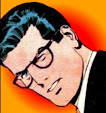
The Blog Pop Sculpture featured an interview with artist Karen Palinko, who is a sculptor and also the creator of the I-cannot-wait-to-have-it-in-my-hands upcoming Red Lantern Mera action figure. This is a snippet of her interview with Pop Sculpture regarding the creation of this piece of art:
 "One of the first challenges I faced sculpting this figure was figuring out how to make her look angry and attractive at the same time. Pushed too far, angry features can become so distorted that the face becomes ugly. It’s a fine line to walk—putting in enough facial lines and distortion to convey emotion, but not so much as to make the character look grotesque. What I decided on was an ‘up and down’ directional pull to the face rather than a ‘side to side’ one. Pulling the facial muscles outward to create a wide gaping mouth works well on male figures, but for an attractive woman, I wanted more of snarl than a grimace, to make the finished product look angry-sexy, not angry-ugly ."
"One of the first challenges I faced sculpting this figure was figuring out how to make her look angry and attractive at the same time. Pushed too far, angry features can become so distorted that the face becomes ugly. It’s a fine line to walk—putting in enough facial lines and distortion to convey emotion, but not so much as to make the character look grotesque. What I decided on was an ‘up and down’ directional pull to the face rather than a ‘side to side’ one. Pulling the facial muscles outward to create a wide gaping mouth works well on male figures, but for an attractive woman, I wanted more of snarl than a grimace, to make the finished product look angry-sexy, not angry-ugly ." "I’ve sculpted a lot of female characters, and one of my favorite parts is doing what I think of as "swishy" hair. A superheroine needs good, swishy hair. Hair does more than make the figure attractive---it’s a continuation of the action; and done right, it adds energy and dynamics to the figure. I also find it very relaxing to sculpt. To me, it feels like a swirly abstract sculpture within a sculpture. But while half of my brain is relaxing and sculpting it, the other half is keeping in mind that it has to be castable. I try to be careful to work the strands so that they feed into each other, or that gates can easily be positioned from one strand to the next so the whole thing can be pulled out of the mold easily."
"I’ve sculpted a lot of female characters, and one of my favorite parts is doing what I think of as "swishy" hair. A superheroine needs good, swishy hair. Hair does more than make the figure attractive---it’s a continuation of the action; and done right, it adds energy and dynamics to the figure. I also find it very relaxing to sculpt. To me, it feels like a swirly abstract sculpture within a sculpture. But while half of my brain is relaxing and sculpting it, the other half is keeping in mind that it has to be castable. I try to be careful to work the strands so that they feed into each other, or that gates can easily be positioned from one strand to the next so the whole thing can be pulled out of the mold easily."
"Like Aquaman, Mera’s costume is composed of countless fish-like scales, which require painstaking effort to get right. Unfortunately, there’s no painless way to put all those scales in place. Each one had to sculpted on individually, using tiny dots of wax. I sculpt the figure first, laying in the musculature, and then apply the scales on top. I sculpted the Mera body underneath to be a little thinner than I would have usually, to allow for the added thickness of the scales. Sometimes this takes some trial and error to get it right, and I have on occasion had to strip the scales off a section to redo them if I thought a limb looked too thin or too heavy after applying the scales. Scales also take some planning ahead, since when applying them on a 3-D shape, the rows will have to contour around the curves of the body. I lay out etched guidelines on the figure to plan where the rows will fall."
























No comments:
Post a Comment